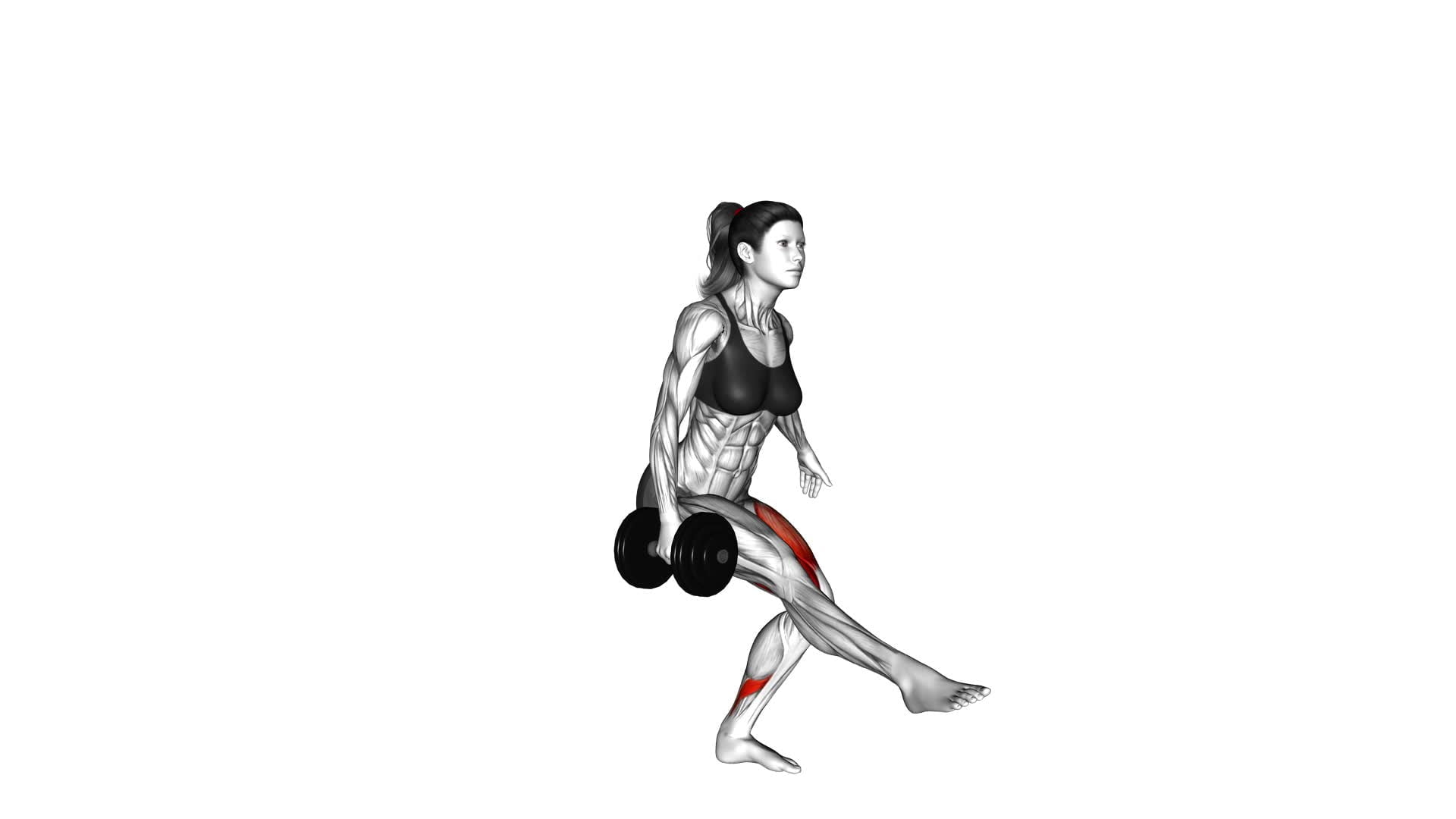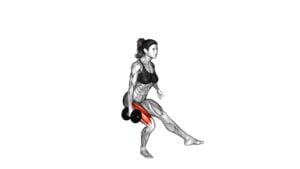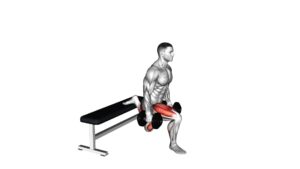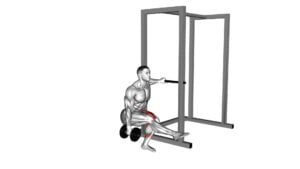Dumbbell Single Leg Squat (female) – Video Exercise Guide & Tips

Are you looking for an effective lower body exercise to strengthen your legs? Look no further than the dumbbell single leg squat!
Watch This Exercise Video
This exercise targets your quads, hamstrings, and glutes, helping you build strength and stability.
In this video exercise guide, we'll show you the proper form and technique, as well as modifications for beginners and advanced variations for fitness enthusiasts.
Maximize your results with these expert tips.
Let's get squatting!
Key Takeaways
- Dumbbell Single Leg Squat targets quads, hamstrings, glutes, and calves, improving lower body strength and stability.
- Proper form and technique are crucial to maintaining balance, stability, and preventing knee pain and lower back strain.
- Beginners can modify the exercise by using a bench or chair for added stability and gradually increasing the depth of the squat.
- Maximizing results requires implementing proper form and control, gradually increasing difficulty, prioritizing rest and recovery, and maintaining consistency in training.
Benefits of Dumbbell Single Leg Squat
To understand the benefits of the Dumbbell Single Leg Squat, you need to know that it can significantly improve your lower body strength and stability. This exercise targets your quadriceps, hamstrings, glutes, and calves, helping you build increased strength in these muscle groups. By performing the Dumbbell Single Leg Squat regularly, you can expect to see improvements in your overall lower body strength.
Additionally, this exercise also enhances your balance and stability. The unilateral nature of the movement requires you to engage your core and stabilizing muscles to maintain proper form and balance. This not only benefits your physical performance but also reduces the risk of injuries, especially in activities that require balance, such as running or playing sports.
The Dumbbell Single Leg Squat is an effective exercise for both beginners and advanced fitness enthusiasts. Start with lighter dumbbells and gradually increase the weight as your strength improves. Remember to maintain proper form throughout the exercise, keeping your chest up, core engaged, and knees in line with your toes.
Incorporating the Dumbbell Single Leg Squat into your workout routine can yield significant improvements in both strength and balance, making it an excellent exercise choice for anyone looking to enhance their lower body fitness.
Proper Form and Technique
To perform the Dumbbell Single Leg Squat with proper form and technique, follow these guidelines:
- Maintain balance: Stand tall on one leg with your core engaged and shoulders back. Keep your gaze forward and your chest lifted throughout the exercise.
- Control the movement: Slowly lower your body by bending the knee of the standing leg, while simultaneously extending the other leg straight out in front of you. Go as far down as you can while maintaining control and stability.
- Use proper alignment: As you descend, make sure your knee stays in line with your toes and doesn't cave inward. Keep your chest lifted and your back straight to avoid rounding or arching.
Common mistakes to avoid:
- Leaning forward: This can put strain on your lower back and decrease the effectiveness of the exercise. Keep your torso upright and avoid leaning too far forward.
- Allowing your knee to collapse: This can lead to knee injuries. Focus on keeping your knee in line with your toes throughout the movement.
Common injuries to watch out for:
- Knee pain: Improper form or excessive strain can lead to knee pain. If you experience any discomfort, stop the exercise and consult a professional.
- Lower back strain: Leaning forward or rounding your back can strain the muscles in your lower back. Maintain proper alignment to prevent this.
Modifications for Beginners
For beginners, you can modify the Dumbbell Single Leg Squat by using a bench or chair for added stability and support. This modification is helpful if you struggle with balance or have weak leg muscles. To perform the modified version, start by standing in front of the bench or chair. Extend one leg forward and keep your foot off the ground. Slowly lower your body down towards the bench or chair, bending your standing leg and keeping your back straight. Touch the bench or chair lightly with your glutes, then push through your heel to return to the starting position. Repeat on the other leg.
Using a bench or chair provides additional stability and support, making the exercise more manageable for beginners. It also helps to prevent common mistakes such as losing balance or not maintaining proper form. Remember to keep your core engaged and your chest lifted throughout the exercise. It's important to focus on proper technique and control rather than rushing through the movement.
As you become more comfortable and confident, you can gradually increase the depth of your squat and eventually progress to the full Dumbbell Single Leg Squat.
Advanced Variations for Fitness Enthusiasts
Now let's explore advanced variations that will challenge fitness enthusiasts and further enhance their Dumbbell Single Leg Squat. These advanced modifications will take your workout to the next level and help you achieve even greater results.
Here are three key variations to consider:
- Pistol Squat with Dumbbells: This variation adds an extra challenge by holding dumbbells in each hand. The added weight increases the resistance, forcing your muscles to work harder and promoting greater strength gains.
- Explosive Single Leg Squat: This dynamic variation focuses on power and explosiveness. Start by lowering yourself into a single leg squat, then explode upwards, jumping off your supporting leg. Land softly and repeat on the other leg. This exercise not only improves strength but also enhances agility and coordination.
- Bulgarian Split Squat with Dumbbells: This variation targets your glutes, quads, and hamstrings even more intensely. Stand facing away from a bench or step, place one foot on it, and hold dumbbells in each hand. Lower yourself into a lunge position, ensuring your front knee doesn't go past your toes. Push through your front heel to return to the starting position.
While these advanced variations can be highly effective, it's important to be mindful of common mistakes. Avoid compromising form for the sake of adding more weight or speed. Focus on maintaining proper alignment and control throughout each movement.
Tips to Maximize Results
Maximize your results by implementing these key strategies.
To track your progress effectively, keep a workout log where you record the weight used, sets, and repetitions for each exercise. This will help you monitor your improvement over time and adjust your training accordingly.
Additionally, take measurements of your body, such as waist circumference and body fat percentage, to see how your physique is changing.
Avoid these common mistakes to ensure optimal results.
First, don't rush through the exercise. Take your time to perform each repetition with proper form and control.
Secondly, avoid using momentum to lift the weights. Focus on using your muscles to perform the movement instead.
Thirdly, don't neglect the mind-muscle connection. Concentrate on engaging the targeted muscles throughout the exercise to maximize their activation.
Furthermore, make sure you're challenging yourself appropriately. Gradually increase the weight or difficulty level as you become stronger and more comfortable with the exercise. Pushing yourself outside of your comfort zone is key to making progress.
Finally, prioritize rest and recovery. Give your muscles time to repair and grow stronger between workouts.
Frequently Asked Questions
How Many Sets and Reps Should I Do for the Dumbbell Single Leg Squat?
For the dumbbell single leg squat, it's important to consider your fitness level and goals. Generally, start with 2-3 sets of 8-12 reps per leg.
As you progress, you can increase the number of sets and reps. You can also try variations of the dumbbell single leg squat, like using different weights or adding a balance challenge.
Remember to listen to your body and adjust the sets and reps accordingly.
Can I Use a Kettlebell Instead of a Dumbbell for This Exercise?
Yes, you can use a kettlebell instead of a dumbbell for the single leg squat. The benefit of using a kettlebell is that it can add an extra challenge to your workout and engage your core muscles more.
However, there are also drawbacks to using a kettlebell, as it may be more difficult to maintain proper form and balance. Make sure to start with a lighter weight and focus on maintaining good technique to avoid injury.
Is It Okay to Perform This Exercise With a Knee Injury?
If you have a knee injury, it's important to modify the dumbbell single leg squat exercise. You should avoid putting excessive strain on your injured knee.
Instead, focus on exercises that are less demanding on your knee joint, such as seated leg exercises or using resistance bands.
Always consult with a healthcare professional or a certified trainer for specific exercises that are safe for your knee injury.
Should I Perform This Exercise at the Beginning or End of My Workout?
When is the best time to perform the dumbbell single leg squat in your workout routine? Should you do it at the beginning or end?
It's important to consider your goals and preferences. If you're looking to build strength and power, it may be beneficial to perform this exercise towards the beginning of your workout when you have more energy.
However, if you're focusing on endurance and stability, doing it at the end can help fatigue your muscles and challenge your balance.
Can I Incorporate This Exercise Into a Full-Body Workout Routine?
You can definitely incorporate the single leg squat into your full-body workout routine. It's a great exercise that targets multiple muscle groups and improves balance and stability.
There are variations of the single leg squat that you can choose from depending on your fitness level. Start with bodyweight squats and gradually add dumbbells for added resistance.
Remember to maintain proper form and listen to your body to prevent any injuries.
Conclusion
In conclusion, the dumbbell single leg squat is a highly effective exercise for strengthening and toning the lower body.
By incorporating dumbbells, you can increase the intensity and challenge your muscles even further.
Remember to maintain proper form and technique throughout the exercise to avoid any injuries.
Beginners can start with modifications and gradually progress to more advanced variations.
Follow these tips to maximize your results and enjoy the benefits of this powerful exercise.

Author
Years ago, the spark of my life’s passion ignited in my mind the moment I stepped into the local gym for the first time. The inaugural bead of perspiration, the initial endeavor, the very first surge of endorphins, and a sense of pride that washed over me post-workout marked the beginning of my deep-seated interest in strength sports, fitness, and sports nutrition. This very curiosity blossomed rapidly into a profound fascination, propelling me to earn a Master’s degree in Physical Education from the Academy of Physical Education in Krakow, followed by a Sports Manager diploma from the Jagiellonian University. My journey of growth led me to gain more specialized qualifications, such as being a certified personal trainer with a focus on sports dietetics, a lifeguard, and an instructor for wellness and corrective gymnastics. Theoretical knowledge paired seamlessly with practical experience, reinforcing my belief that the transformation of individuals under my guidance was also a reflection of my personal growth. This belief holds true even today. Each day, I strive to push the boundaries and explore new realms. These realms gently elevate me to greater heights. The unique combination of passion for my field and the continuous quest for growth fuels my drive to break new ground.



